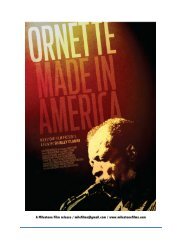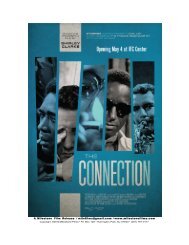ORNETTE Press Kit.8.7.2012 - Shirley Clarke
ORNETTE Press Kit.8.7.2012 - Shirley Clarke
ORNETTE Press Kit.8.7.2012 - Shirley Clarke
You also want an ePaper? Increase the reach of your titles
YUMPU automatically turns print PDFs into web optimized ePapers that Google loves.
Synopsis<br />
1983. Fort Worth, Texas. There is a re-‐enactment of the Luke Short and Tim “Long<br />
Haired Jim” Courtwright gunfight on Main Street. That original duel took place on<br />
February 8, 1887 outside the White Elephant Saloon where the two dangerous men had<br />
argued. Short fired first, taking off Courtright's right thumb. Courtright attempted to<br />
switch his gun to the uninjured hand — pulling a “border shift” — but he was too slow.<br />
Luke Short killed him with a shot to the chest.<br />
After the re-‐enactment, Fort Worth’s mayor Bob Bolen presents Ornette with the key to<br />
the city on the courthouse steps and proclaims that day, September 23, 1983, “Ornette<br />
Coleman Day.” That night, Coleman performs at the opening of fellow Fort Worth native<br />
and billionaire philanthropist Ed Bass’ Caravan of Dreams music complex. The film cuts<br />
to this performance of Ornette’s symphony Skies of America with the John Giordano-‐led<br />
Fort Worth Symphony at the city’s Convention Center. There’s also a performance of<br />
Ornette’s Prime Design/Time Design by a string quartet under the geodesic dome in<br />
Caravan of Dreams’ rooftop garden (later released as a separate album), along with an<br />
interview with his son (and Prime Time’s drummer), Denardo.<br />
It’s 1968 and Ornette is playing with Denardo and bassist Charlie Haden. He speaks with<br />
his young son about his future prospects as an artist. We’re now in the early 70s with<br />
<strong>Clarke</strong>’s 8mm and 16mm footage of Ornette visiting Nigerian tribal musicians and the<br />
Master Musicians of Jajouka.<br />
Ornette then revisits the small house right next to the train tracks where he was born<br />
and reminisces with the home folks. Then he’s back in NYC talking music with composer<br />
George Russell and the late jazz scribe Robert Palmer.<br />
<strong>Shirley</strong> <strong>Clarke</strong> stated her attempt to emulate Coleman’s free jazz style in her brilliant<br />
directing and editing of the film. Eschewing a standard pace, plot structure or consistent<br />
recording medium, <strong>Clarke</strong> cuts to such clips as the theater troupe from Caravan of<br />
Dreams prancing down the street, Washington D.C.’s shanty “Resurrection City” in 1968<br />
and experimental music videos shot on video. The latter videos explore a prominent<br />
visual motif of the film — The Caravan of Dream’s neon logo of the red square, orange<br />
circle and blue triangle. The young Coleman, played by Demon Marshall and Gene Tatum,<br />
appear in flashbacks, and in the present-‐day where Ornette’s older self watches over the<br />
boy.<br />
An interview with Denardo near the end of the film recounts a particularly harrowing<br />
story when six teenagers robbed, tied up and severely beat Ornette while he lived in a<br />
dilapidated schoolhouse on the Lower East Side of Manhattan. Only a few months later,<br />
both Denardo and Ornette were attacked in the same building by other thugs, to which<br />
Ornette suffered a punctured lung. Both of these incidents took place in 1982 and ’83,<br />
only a couple years before the film’s release in ’85. Ornette offers his plans to convert<br />
this poor building into a school of music, taking the violence he has faced in stride and<br />
promising better futures for the children after him.




